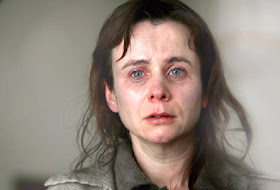He's one mother of a father, that Lenny, the main character of Ben and Joshua Safdie's (shown below) Sun-
dance-premiered DADDY LONG-
LEGS (originally titled Go Get Some Rosemary, though neither name works particularly well). In the film's first 20 minutes, Lenny gets into an embarrassing fight with the principal when he picks his kids up from school; does handstands on the sidewalk as they make their way home; teaches the kids handball at the gym (and gets propositioned in the changing room by another male member); meets a young woman in a bar, goes home with her, and then on to a little impromptu vacation to upstate New York with her, his kids -- and his new lady's boyfriend.
Were Lenny -- who is played exceedingly well by Ronald Bronstein (also also helped with this film's script and editing and is the writer/director/editor of the much-acclaimed Frownland) -- not so full of life and energy (and pretty cute, to boot), he might grate on us (and everyone around him in the film) much sooner than he does. After the family's short vacation, during which we're treated to the seeing and hearing a singing water-skier, we're back in the city at work with Dad (he's a projectionist at what looks to TrustMovies like NYC's Cinema Village theater).
The kids, meanwhile, are back in a school that, from the looks of the math class, is definitely "alternative" but a lot of fun. One of the teachers on view even sports a black eye. The Safdie's hand-held camera (the cinematography's by Joshua and Brett Jutkiewicz) catches well many off-the-cuff moments & great facial expressions.
It's when, around halfway along, Lenny (above, left) makes a decision that could truly endanger his kids that the viewer's sympathy -- mine, at least -- begins to wane badly. (And yes, being a father myself, I know just how difficult it is to sometimes make the right decision.) Worse, Dad's reaction to what he has done is almost as crazy and goes against any real, responsible fatherly feelings. And then he takes a further step into full-out stupidity. (While the event in question is perhaps not as completely unfeeling as is the response of the Bradley Cooper character in The Hangover to leaving an untended baby in an apartment with a full-grown tiger, it comes awfully close.)
Now, this is perfectly OK: If that's who this guy is, let's call a spade a spade. Yet the filmmakers, not to mention the actor, seem to love Lenny so much that they'll let him get away with just about anything -- which by the finale, he pretty much has. (From what I can gather, Lenny's character is based somewhat upon the Safdie brothers' own father.) We don't see the results of Dad's final fling, but if there's any justice in the world (yeah, right), he'll lose complete custody of those kids and be plagued with a bad back for the remainder of his life.
Daddy Longlegs is a constant fight between the male need to flake (and stay a child) and children's need to be cared for. Unfortun-
ately flake wins, though were the film to continue for another day or two, he would not. As talented a pair of filmmakers as are the Safdie's -- and they are! -- they've not quite nailed their movie. What seems to be an ode to (or at least a look at) the plight of part-time-custody dads who balance work, kids and girlfriends is finally in thrall to such an aberrant personality disorder that the movie, good as are many of its parts, finally goes off-orbit. When Lenny pulls his final asshole number, only a few like-minded males will still be on board.
This film completes the trilogy of Sundance Selects titles (7 Days and The Shock Doctrine were covered earlier) that made their debut at the just-ended Sundance Film Festival and will now be available On-Demand from most major cable systems, including Comcast, Cablevision, Cox, Time Warner and satellite provider Direct TV until approximately the end of February. To find the film, look at the directory of titles available on these cable systems' main movies-on-demand channel.


















































